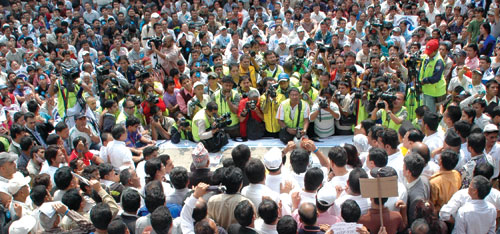 DAMBAR K SHRESTHA |
Nepali society is too complex for the small screen to be the decisive factor in electoral politics. But cameras do play an important role in swaying public opinion. The public assembly at Basantapur Square last week was a staged-for-television event. With the involvement of television personality Bhaskar Rajkarnikar, who popularised telecasts of staged street events almost two decades ago, the presentation was foolproof from the word go.
There were weightier factors at play � lobbying by diplomats, phone calls from foreign capitals and pressure from fatigued cadres, for example � during the final moments of the stand-off between Maoist and anti-Maoist forces last week. However, the clincher was perhaps the spectacle captured by television cameras at the peace assembly.
Pushpa Kamal Dahal had good reason to foam at the mouth while cursing the media during his speech at Khula Manch the following day. Newspapers did play some role in demonising the Maoists. FM radio stations had to be loyal to advertisers and their target audience. However, at least part of the reason behind the Maoists' media debacle lies in the medium: television is ineffective in depicting ideological conflicts. Issue-based politics belong to the print media, but microphones want sound clips and cameras love media personalities.
Leftwing politics held a competitive advantage when its arguments made audiences think. It held its ground during the radio boom in Nepal. Those who made the loudest and most inflammatory speeches hogged the limelight. Television cameras, by contrast, have little time for nuances and even less inclination to report verbosity.
It was the press that transformed Maoist fugitives into heroes during the decade of armed struggle. Ironically, those journalists who lionised violent insurgents are now their biggest critics. There is a reason for their somersault: Nepal's Maoists have failed to oblige the middle class by abandoning their political agenda as UML did in the mid-nineties. The animosity of the 'reformed' Nepali media towards its former idols is thus understandable.
Through his inflammatory speeches from Khula Manch, Dahal was playing a game that lost its efficacy years ago. In the early nineties, the late Madan Bhandari courted courtiers by night and hit back at them through fiery speeches during the day. The tactic helped UML retain some of its mass base even as it transformed itself into a party of the urban bourgeoisie. But it worked mainly because there were no television cameras to magnify the contortions of Bhandari's face for the middle class in their living rooms. This time, viewers watched Dahal fume from dozens of channels live and, simply put, became very afraid.
The Maoists need not despair, however. They may be novices at playing to the gallery through the medium of television, but their rivals are no professionals either. TV cameras exaggerate the nervousness of Ram Chandra Paudel, the aggression of Sher Bahadur Deuba and the helplessness of Sushil Koirala. Madhav Nepal looks cuddly, but fails to inspire confidence. Khanal is telegenic and Oli dresses well for the press, but both appear inauthentic.
Among Madhesi politicos, Upendra Yadav bumbles his way through television interviews and Mahanta Thakur is perennially defensive, the mark of a weak media personality. In comparison, Dahal oozes confidence and Baburam Bhattarai comes across as a somewhat cranky university don: perhaps too self-righteous, but not that unreasonable.
The Maoists have lost this round, but the media war for the attention of television viewers has just begun.
READ MORE:
Letting go- By Prashant Jha
Wanted: leaders - By Krishna Khanal
Less revolting - By Kiran Nepal
Relief and despair - Publisher's Note
Proximate breakthrough
Get the message across - By Ashutosh Tiwari



